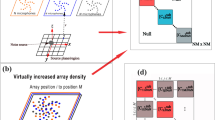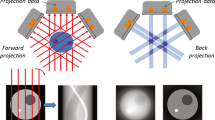Abstract
Purpose
The generalized coherence factor (GCF), an adaptive beamforming technique, can reduce unnecessary signals from an unfocused position without reducing the contrast-to-noise ratio. However, the computational complexity of this method is large compared to the conventional delay-and-sum (DAS) beamformer. In the present paper, we propose a novel method to achieve the same reduction effect of unnecessary signals with a smaller computational load than that of the conventional GCF approach.
Methods
One of the factors increasing the computational complexity of the GCF-based beamformer compared with DAS is the generation of analytic signals at receiving elements. We clarified the mechanism of generating unnecessary signal components to enable the calculation of the GCF value directly from real signals without generating analytic signals. Furthermore, we proposed a method to filter out these components without generating analytic signals.
Results
The GCF values obtained using the proposed and conventional methods were compared and verified using the actual data acquired from a phantom with an ultrasound diagnostic system. We also compared the B-mode images. As a result, equivalent GCF values and similar B-mode image quality were achieved with the proposed method with reduced computational complexity.
Conclusion
With the proposed method, generation of analytic signals at receiving elements can be omitted, and as a result, the computational load of the GCF method can be greatly reduced, while preserving the effect of reducing unnecessary signals like with the conventional method.







Similar content being viewed by others
References
Capon J. High-resolution frequency-wavenumber spectrum analysis. Proc IEEE. 1969;57:1408–18.
Synnevag JF, Austeng A, Holm S. Adaptive beamforming applied to medical ultrasound imaging. IEEE Trans Ultrason Ferroelectr Freq Control. 2007;54:1606–13.
Synnevag JF, Austeng A, Holm S. Benefits of minimum-variance beamforming in medical ultrasound imaging. IEEE Trans Ultrason Ferroelectr Freq Control. 2009;56:1868–79.
Hollman KW, Rigby KW, O’Donnell M. Coherence factor of speckle from a multi-row probe. In: Proceedings of IEEE ultrasonics symposium. IEEE: Los Alamitos, CA; 1999. pp. 1257–1260.
Kanai H, Sato M, Koiwa Y, et al. Transcutaneous measurement and spectrum analysis of hear wall vibrations. IEEE Trans Ultrason Ferroelectr Freq Control. 1996;43:791–810.
Li PC, Li ML. Adaptive imaging using the generalized coherence factor. IEEE Trans Ultrason Ferroelectr Freq Control. 2003;50:128–41.
Wang SL, Chang CH, Yang HC, et al. Performance evaluation of coherence-based adaptive imaging using clinical breast data. IEEE Trans Ultrason Ferroelectr Freq Control. 2007;54:1669–788.
Camacho J, Parrilla M, Fritsch C. Phase coherence imaging. IEEE Trans Ultrason Ferroelectr Freq Control. 2009;56:958–74.
Wang Y, Zheng C, Peng H, et al. An adaptive beamforming method for ultrasound imaging based on the mean to standard deviation factor. Ultrasonics. 2018;90:32–41.
Burckhardt CB. Speckle in ultrasound B-mode scans. IEEE Trans Son Ultrason. 1978;SU-25:1–6.
Wagner RF, Smith SW, Sandrik JM, et al. Statistics of speckle in ultrasound B-scans. IEEE Trans Son Ultrason. 1983;30:156–63.
Hverven SM, Rindal OMH, Rodriguez-Molares A, et al. The influence of speckle statistics on contrast metrics in ultrasound imaging. In: Proceedings of IEEE Ultrasonics Symposium. IEEE: Washington, DC; 2017.
Tuthill TA, Sperry RH, Parker KJ. Deviations from Rayleigh statistics in ultrasonic speckle. Ultrason Imaging. 1988;10:81–9.
Jespersen SK, Wilhjelm JE, Sillesen H. Multi-angle compound imaging. Ultrason Imaging. 1998;20:81–102.
Magnin PA, Von Ramm OT, Thurstone FL. Frequency compounding for speckle contrast reduction in phased array images. Ultrason Imaging. 1982;4:267–81.
Bamber JC, Daft C. Adaptive speckle reduction filter for log-compressed B-scan images. IEEE Trans Med Imaging. 1996;15:802–13.
Karaman M, Kutay MA, Bozdagi G. An adaptive speckle suppression filter for medical ultrasonic imaging. IEEE Trans Med Imaging. 1995;14:283–92.
Hasegawa H, Kanai H. Effect of sub aperture beamforming on phase coherence factor imaging. IEEE Trans Ultrason Ferroelectr Freq Control. 2014;61:1779–900.
Tanter M, Fink M. Ultrafast imaging in biomedical ultrasound. IEEE Trans Ultrason Ferroelectr Freq Control. 2014;61:102–19.
Yiu BYS, Tsang IKH, Yu ACH. GPU-based beamformer: fast realization of plane wave compounding and synthetic aperture imaging. IEEE Trans Ultrason Ferroelectr Freq Control. 2011;58:1698–705.
Shen CC, Xing YQ, Jeng G. Autocorrelation based generalized coherence factor for low-complexity adaptive beamforming. Ultrasonics. 2016;72:177–83.
Rindal OMH, Rodriguez-Molares A, Austeng A. The dark region artifact in adaptive ultrasound beamforming. In: Proceedings of IEEE international Ultrasonics Symposium. IEEE: Washington, DC; 2017.
Patterson MS, Foster FS. The improvement and quantitative assessment of B-mode images produced by an annular array/cone hybrid. Ultrason Imaging. 1983;5:195–213.
Author information
Authors and Affiliations
Corresponding author
Ethics declarations
Conflict of interest
The authors declare that they have no conflicts of interest.
Ethical statements
This article does not contain any studies with human or animal subjects performed by any of the authors.
Additional information
Publisher's Note
Springer Nature remains neutral with regard to jurisdictional claims in published maps and institutional affiliations.
About this article
Cite this article
Hisatsu, M., Mori, S., Arakawa, M. et al. Generalized coherence factor estimated from real signals in ultrasound beamforming. J Med Ultrasonics 47, 179–192 (2020). https://doi.org/10.1007/s10396-019-01004-7
Received:
Accepted:
Published:
Issue Date:
DOI: https://doi.org/10.1007/s10396-019-01004-7




